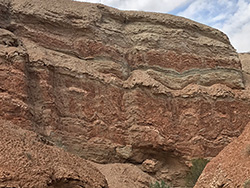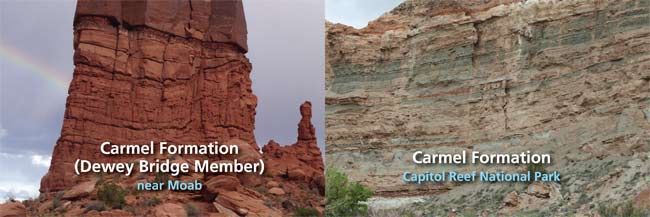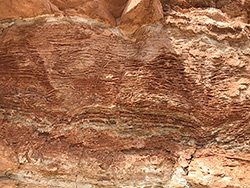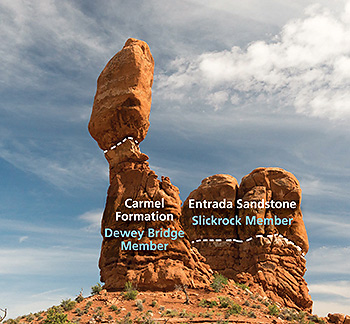 |
| A typical outcrop of the Carmel Formation with wavy and contorted beds. |
Each of the rock layers (formations to geologists) exposed throughout southeastern Utah has stories to tell. Stories of the ancient environments in which their sediments were deposited, whether they were in oceans or seaways, along rivers and in floodplains where dinosaurs once walked, or in vast sand dunefields with pockets of life found at pools in low areas between the dunes. A rock layer’s stories also include ones from the much more recent geologic past when these layers were uplifted to elevations well above sea level, sometimes folded, tilted, or cut by geologic faults, and finally carved by water, gravity, and wind into the cliffs, canyons, rock spires, and ridges that surround Moab.
Although each layer tells both the stories of deposition (the processes wherein sediment is laid down after being transported by water, wind, or ice), and those of uplift and erosion, different layers are typically more notable for one or the other. For example, the Morrison Formation is best known for the dinosaur and other fossils it contains. The Entrada Sandstone is heralded for its erosional landforms, specifically the natural arches in Arches National Park and the stone hoodoos (or goblins) of Goblin Valley State Park.
The Carmel Formation is a bit different. Its most readily apparent feature is neither a direct result of deposition nor a type of erosional landform. Instead, the Carmel stands out for events that took place after the Carmel sediments were deposited and buried by younger layers of rock, but before they were lithified (turned into stone), much less exposed by erosion and carved into desert landscapes.
 |
| Two views of the Carmel Formation. A unique red-colored subdivision of the Carmel Formation, the Dewey Bridge Member, is present near Moab. In other areas, the Carmel Formation consists of red, gray, and greenish layers of mudstone and gypsum, like in Capitol Reef National Park. |
The Carmel Formation contains wavy and contorted beds (layers) that are strikingly different than the regular bedding found in other rock units. They formed by processes known as soft sediment deformation. Soft sediment deformation is
 |
| Small veins of gypsum make a lattice-work in a Carmel Formation outcrop in Capitol Reef National Park. The gypsum in the Carmel may have been the source for these stringers that formed later in the process of sediment turning into stone. |
exactly what it sounds like: while the sediment is still soft, the sediment warps and may even flow in response to some type of stress. Soft sediment deformation can happen in any type of sediment, but most often occurs when they are saturated with water and subjected to some sort of instability. This instability may be caused by rapid deposition of additional layers on top of the buried sediment, water escaping from saturated sediments, stress such as that caused by seismic shaking during earthquakes, or other factors.
Although the Carmel’s soft sedimentary deformation features are its most distinctive characteristic, the types of sediments found in the unit, and hence its depositional environment, are essential to the formation of those structures. The Carmel Formation was deposited about 165 million years ago throughout much of southern Utah (and extending into northern Arizona). It was deposited in and along the arm of a shallow sea that extended from the north to the south through the center part of the state. The specific depositional environment of the Carmel Formation varied somewhat from place to place, depending on the location of any given area relative to the seaway as well as subtle changes in sea level that caused the sea to advance or retreat, but it was mostly deposited under shallow marine conditions.
Throughout most of the area where it is found, the Carmel contains gypsum beds which were precipitated through evaporation of seawater. Gypsum may play a role in the formation of soft sediment deformation structures in two ways. One, gypsum is soluble and it may be dissolved by circulating groundwater. The removal of gypsum layers may cause the other beds to warp. Second, gypsum is weak and may flow somewhat under the stress of being buried by other sediments also distorting the original bedding.
 |
| Balanced Rock and the Windows Section in Arches National Park consist of the Dewey Bridge Member of the Carmel overlain by the Slick Rock Member of the Entrada Sandstone. The Dewey Bridge was once thought to be a part of the Entrada Sandstone, but it has been properly reclassified as a member of the Carmel Formation.Original photo: Chris Wonderly/NPS. |
The Dewey Bridge Member is a unique subdivision of the Carmel Formation found only in the Moab area. The Dewey Bridge Member represents a facies, which is a distinct rock type found in a formation that is present in only a certain geographic area. The region in eastern Utah where the Dewey Bridge is present was a good distance from the narrow seaway in which most of the rest of the Carmel was deposited, so it is not marine in origin. But otherwise, its depositional environment is a bit enigmatic. The Dewey Bridge contains no fossils and lacks features like ripple marks that provide information about ancient environments. The most likely scenario was that it was deposited under arid to semiarid conditions on a type of mud flat above the tidal level known as a sabkha.
For a while, geologists thought that the Dewey Bridge Member was a part of the overlying Entrada Formation, but researchers have been able to trace it to the Carmel Formation to the west in the San Rafael Swell, so it has been reassigned. Although the Dewey Bridge lacks the gypsum usually found in the Carmel in other areas, it does have that classic Carmel calling card: wavy, contorted beds. Like the rest of the Carmel Formation, its sedimentary beds underwent deformation while still soft.
|